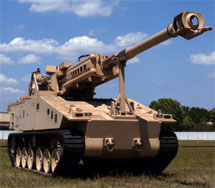One of the weapons to start outfitting the Future Combat System is fast, mobile artillery. The promise of this was the Non-Line Of Sight Cannon (NLOS-C). I last reported on this system in this article covering current and upcoming changes to the armed forces.

A stationary missile module (NLOS-M if I remember correctly) will supplement combat ops by being a deployable system via air or trucking and then left in 'stand-by' mode to receive missile firing orders. These two components will take care of many mobile targets and emplacements that used to wait for Combat Air Support or the M-109 or M-1 to get into place. The older method of integrated operations has been known on the battlefield for years in Iraq, but something to get regional coverage and help with light, fast troops have been prime considerations for the new force mix of the US Armed Forces. Thus the NLOS concept is critical for support of infantry operations, special forces and other organizations that face ranged threats on the move.
The NLOS-C is going into limited production this year (h/t: Strategypage), mostly for trial units and system integration and familiarization, and then limited annual production from then on. This system is different than its predecessors in that it carries an auto-loader and precision fire system as part of its main offensive system. Germany has fielded their heavier version of this system depending upon more armor and less active defensive systems, but their work has demonstrated a fire rate of 4-8 rounds per minute (10 for sudden need) with 6 being a sustainable firing sequence for minutes until the combat load of the vehicle runs out. By automating the loading system for the weapon, this vehicle has reduced crew size (3 man crew) and had to meet weight limits for it to be delivered by aircraft (target weight of 20 tons). The initial test system has now allowed for this limited production run to start and the next step up is a full test of integration across multiple units.
The NLOS-C is going into limited production this year (h/t: Strategypage), mostly for trial units and system integration and familiarization, and then limited annual production from then on. This system is different than its predecessors in that it carries an auto-loader and precision fire system as part of its main offensive system. Germany has fielded their heavier version of this system depending upon more armor and less active defensive systems, but their work has demonstrated a fire rate of 4-8 rounds per minute (10 for sudden need) with 6 being a sustainable firing sequence for minutes until the combat load of the vehicle runs out. By automating the loading system for the weapon, this vehicle has reduced crew size (3 man crew) and had to meet weight limits for it to be delivered by aircraft (target weight of 20 tons). The initial test system has now allowed for this limited production run to start and the next step up is a full test of integration across multiple units.
The NLOS-C is not a 'radio to and wait for incoming' unit, but one that operates to get multiple rounds on-target simultaneously via changing the firing angle of the main gun. Beyond that, Germany has demonstrated cross unit communication to have multiple of their systems coordinate fire for simultaneous time-on-target across them. This is *nothing* like previous generations of howitzers and mobile artillery, in that regards.
To meet weight limits the NLOS-C has scrimped on armor, going for high-tech composites, changed over to a durable rubber/plastic tread design instead of metal, and moved to a diesel/electric hybrid engine. Compensating for reduced armor is an active defense system to shoot at incoming RPG's and human attackers via means of measuring size and speed of approach of an object. These things, combined, put its road speed at 55 mph and broken terrain speed at 35-40 mph. The electric part of the hybrid allows the NLOS-C to operate fully off of batteries for movement at 20 mph and nearly silently, due to tread design, for 20 minutes or so at a minimum. This gives the NLOS-C a previously unheard of stealth capability to shift through hostile zones and change firing positions or take up one for a first time and barely be heard.
Together with the new Strykers that have the field combat support system on-board, the NLOS-C will add to the capability of those and cross-integrate through that down to the individual level.
Also being fielded for deployment is the Unmanned Ground Combat Vehicle which has quickly been moved from the CMU self-guided vehicle grand challenge into production. By marrying up self-drive and remote drive, this vehicle offers resupply of troops in isolated locations, the ability to protect itself and deal with obstacles on its own. I first looked at this with this post on the evolving technology for robots in farming and industry.

This system will also offer ways to get wounded out of such areas and give feedback via the systems it carries on-board which will also integrate with the rest of the FCS.
[UPDATE] Originally this was a longer post, but blogger has seen fit to not update properly, so the rest of the thoughts shall wait for another time. What is important is to see that the US Armed Forces are 'upgrading on-the-fly' and shifting to better means to function across the battlespace. This means more accurate use of firepower on targets so as to minimize 'collateral damage' to civilians and yet remove fighters from civilian surroundings. The augmenting of such forces with robotic systems for support and re-supply also limits exposure by the Armed Forces to hostile fire, and yet gives a minimum of continued surveillance over the points between base and operations in the field.




 Supporting Friends and Allies
Supporting Friends and Allies









No comments:
Post a Comment